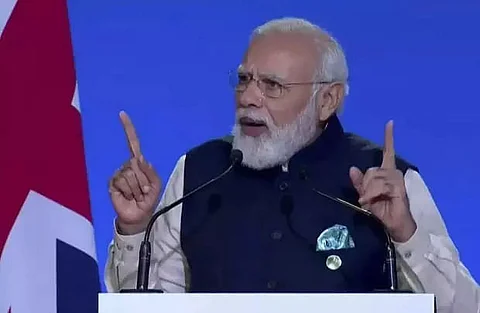
- Home
- Live Blog
- Breaking News
- Top Headlines
- Cities
- NE News
- Sentinel Media
- Sports
- Education
- Jobs

Prime Minister Narendra Modi's announcement at the COP26 summit in Glasgow on India's national targets for combating climate change is a clear signal that the country will be embarking on a new energy trajectory to cut down carbon emission significantly by this decade-end. Meeting the targets towards the goal of net-zero carbon emission by 2070 will be quite challenging and will also require drawing up detailed time-bound state-specific action plans. The targets announced by the Prime Minister include the country reaching its non-fossil energy capacity to 500 GW, meeting 50 per cent of its energy requirements from renewable energy, reducing total projected carbon emission by one billion tonnes from now onwards and reducing the carbon intensity of its economy by less than 45 per cent by 2030. Countries phasing out coal and other fossil fuels from the energy mix, preventing deforestation and using renewable sources is critical to limit the total global warming to 1.5 degrees Celsius. The COP26 Summit had drawn wide attention in the wake of the Intergovernmental Panel on Climate Change (IPCC) warning that unless there are immediate, rapid, and large-scale reductions in greenhouse gas emissions, limiting warming to close to 1.5°C or even 2°C will be beyond reach. The IPCC also estimated that at 1.5°C of global warming, there will be increased heat waves, longer warm seasons and shorter cold seasons while at 2°C of global warming, heat extremes would more often reach critical tolerance thresholds for agriculture and health. In India's current energy mix, fossil fuels account for 60.2% of the installed generation capacity. Coal accounts for the highest 51.9% of the total fossil fuel-based installed capacity. Replacing coal and other fossil fuel with non-fossil fuels is surely a gigantic task and going by the country's target coal and gas will continue to account for 55% of total power generation in 2030. The Report on "optimal Generation Mix for 2029-30" of the Central Electricity Authority states that the installed capacity of the country as of September 30, 1029, is 363.4 GW which comprises 45.4 GW from Hydro, 228.6 GW from Thermal (fossil fuel-based), 82.6 GW from renewables (solar, wind, biomass) and 6.8 GW from Nuclear. The National Institute of Solar Energy estimates the country's total solar energy potential at 748.98 GW and, therefore, the target of 500 GW of renewable energy by the decade-end is achievable. The National Institute of Wind Energy estimates the total win potential at 80-metre sub-height level at 748 GW. Meeting the yearly targets and ensuing dedicated funds for the projects will be crucial to stay on course. Projection by the CEA for 2030 indicates that India is going to add 32 GW of coal-powered power generation to a current installed capacity of 228 GW. The Central government approved all hydropower projects irrespective of size and generation capacity as renewables in 2019 revived the debate the large hydropower projects are false solutions to the climate change problem caused by carbon emission from firing fossil fuel to generate electricity. Environment activists argue that dams of large hydel projects hamper the role of the rivers as carbon sinks, construction of mega-dams causes irreversible damage to the ecosystem as it leads to wanton destruction of forests. Before 2019, small hydropower projects up to 25 Megawatts were considered to be renewable along with solar, wind and biomass. This policy shift has huge ramifications for the biodiversity-rich northeast region and calls for a comprehensive scientific estimation of likely carbon emission from large mega hydropower projects under construction or proposed to be built in the region, the majority of them in Arunachal Pradesh. The Dibang Multipurpose project, for instance, will lead to the felling of 3.12 lakh trees and loss of the ecosystem in the proposed dam site which is a huge carbon sink will be irreversible. Ambiguity in the renewable definition must be removed to ensure that India's targets to achieve net-zero emission by 2070 is not derailed by the construction of multiple mega hydel projects pushing them to be a source of renewable and clean energy. Apart from the destruction of forests, the safety of dams is a huge cause of concern for people in downstream areas while disturbing the fragile ecology leads to an aggravation of flash floods in mountain and hilly regions. As India is required to draw up a time-bound action plan to meet the targets announced at the COP 26 Summit, addressing the concern raised over large hydropower projects adding to climate change need to be addressed. Battery-powered electric mobility on roads and railways pushed by India is a timely initiative to cut down carbon emissions but sources of power generation for manufacturing and charging the batteries will be key determinants in estimating how much carbon emission will be reduced by battery-operated electric vehicles or electric locomotives